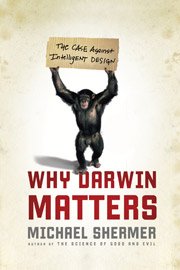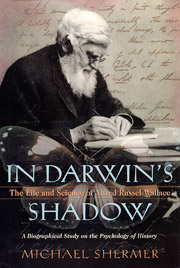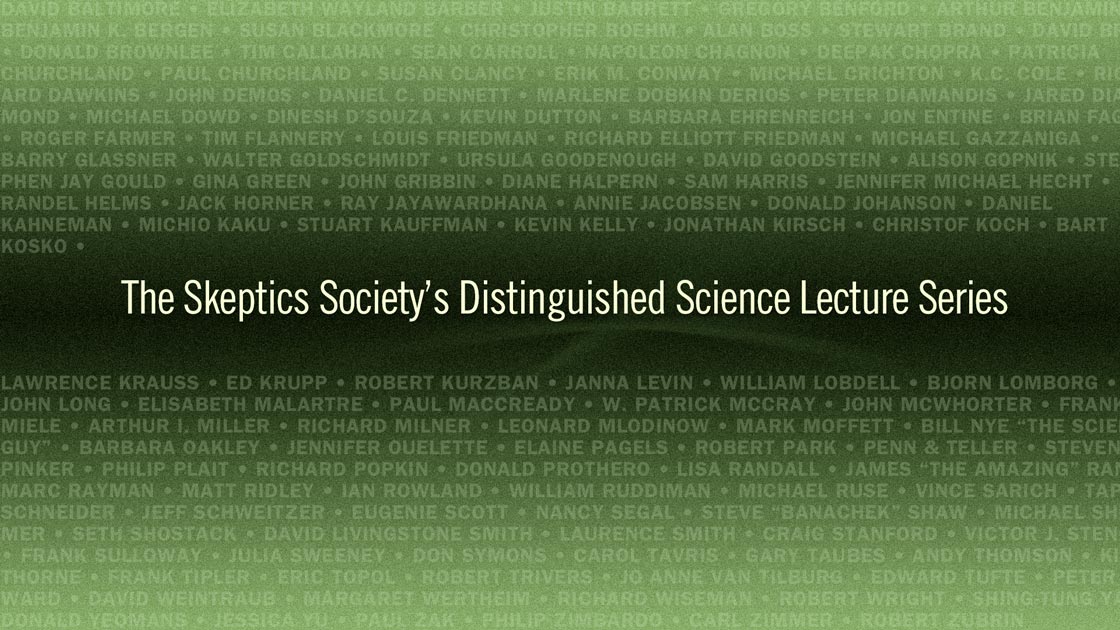In this week’s eSkeptic:
In this week’s eSkeptic, in celebration of Darwin Day, we present an excerpt from Michael Shermer’s book, Why Darwin Matters: The Case Against Intelligent Design, from Chapter 4: “Who the Designer Is.”
Share this article with friends online.
Subscribe | Donate | Watch Lectures | Shop
In Search of the Intelligent Designer
by Michael Shermer
“Man has been here 32,000 years. That it took a hundred million years to prepare the world for him is proof that that is what it was done for. I suppose it is. I dunno. If the Eiffel tower were now representing the world’s age, the skin of paint on the pinnacle-knob at its summit would represent man’s share of that age; and anybody would perceive that that skin was what the tower was built for. I reckon they would, I dunno.”
In a study conducted by Frank J. Sulloway and me on why people believe in God (discussed in detail in another chapter in this book), the most common reason people give is the good design of the world. So when Intelligent Design creationists make the argument from design for the existence of a designer, they are tapping into an intuitive sense most people have about the world. But there is a deep-seated flaw in this argument that undermines the entire endeavor.
If the world is complex and looks intricately designed, and therefore the best inference is that there must be an intelligent designer, should we not then infer that an intelligent designer must itself have been designed? That is, if the earmarks of design imply that there is an intelligent designer, then the existence of an intelligent designer denotes that it must have a designer—a super intelligent designer. And by the same course of reasoning, any designer who can create a super intelligent designer must itself be a superior super intelligent designer.
Ad infinitum. Which brings us right back to the natural world, and the search for natural explanations for natural phenomena.
Shermer’s Last Law: ID, ET, and God
One day I was thinking about what we might find if we went in search of an intelligent designer when I came across Arthur C. Clarke’s famous Third Law: “Any sufficiently advanced technology is indistinguishable from magic.”1 This led me to consider what a sufficiently advanced Extra-Terrestrial Intelligence (ETI) would be indistinguishable from, which led me to formulate Shermer’s Last Law: Any sufficiently advanced Extra-Terrestrial Intelligence is indistinguishable from God.2
God is described by most Western religions as omniscient and omnipotent. Since we are far from the mark on these traits, how could we possibly distinguish a God who has them absolutely, from an Extra-Terrestrial Intelligence who has them in copious amounts relative to us? Thus, we would be unable to distinguish between absolute and relative omniscience and omnipotence. But if God were only relatively more knowing and powerful than us, then by definition He would be an ETI! From this I conclude that there is no difference between ID, ET, and God, at least a God that is part of our world. This conclusion is derived from the following sequence of observations and deductions.

Why Darwin Matters: The Case Against Intelligent Design
$13
Evolution happened, and the theory describing it is one of the most well founded in all of science. Yet millions of people reject it for religious, psychological, and political reasons. Historian of science and bestselling author Michael Shermer defuses these fear-based reasons by examining what evolution really is, how we know it happened, and how to test it. The most common reason people give for why they believe in God is the good design of the world and the life in it. The question is: who or what is the designer? This book examines the difference between supernatural design (creationism) v. natural design (evolution) and how evolution can explain complex design.
Order the paperback
Order the lecture on DVD
Order the abridged CD
Order the Kindle Edition
Order the Apple iBook
Observation. Biological evolution is glacially slow compared to technological evolution. The reason is that biological evolution is Darwinian and requires generations of differential reproductive success, whereas technological evolution is Lamarckian and can be implemented within a single generation.
Observation. The cosmos is very big and space is very empty, so the probability of making contact with ETI is remote. By example, the speed of our most distant spacecraft, Voyager I, relative to the sun is 17.246 kilometers per second. The speed of light is 300,000 k/sec, so Voyager I is traveling at .0000574 percent the speed of light. The Alpha Centauri star system, the closest to our sun, is 4.3 light years away. This means that even traveling at a break-neck speed of 38,578 miles per hour, it would take Voyager 1 74,912 years to get to there (and it isn’t even heading in that direction).3
Deduction. Ergo, the probability of making contact with an ETI who is only slightly more advanced than us is virtually nil. If we ever do encounter ETI it will be as if a million-year-old Homo erectus were dropped into the middle of Manhattan, given a computer and a cell phone, and was instructed to communicate with us. ETI would be to us as we would be to this early hominid—godlike.
Observation. Science and technology have changed our world more in the past century than it changed in the previous hundred centuries—it took 10,000 years to get from the cart to the airplane, but only 66 years to get from powered flight to a lunar landing. Moore’s Law of computer power doubling every eighteen months continues unabated and is now down to about a year. Some computer scientists, such as Ray Kurzweil, calculate that there have been thirty-two doublings since World War II, and that as early as 2030 we may encounter the Singularity—the point at which total computational power will rise to levels that are so far beyond anything that we can imagine that they will appear near infinite and thus, relatively speaking, be indistinguishable from omniscience (note the suffix!).4 When this happens the world will change more in a decade than it did in the previous thousand decades.
Deduction. Extrapolate these trend lines out a hundred thousand years, or a million years (an eye blink on an evolutionary time scale, and thus a realistic estimate of how far advanced ETI will be5), and we get a gut-wrenching, mind-warping feel for just how godlike an ETI would appear to us.
Intelligent Design is Bad Science
By pursuing a course of scientific inquiry to its natural extension of examining the nature of ID, the end result can only be the discovery of ET and the naturalization of God.
What IDers will find (if they find anything) is an alien being capable of engineering DNA, cells, complex organisms, planets, stars, galaxies, and perhaps even universes. If today we can engineer genes, clone mammals, and manipulate stem cells with science and technologies developed in only the last half century, think of what an ETI could do with 100,000 years of equivalent powers of progress in science and technology. For an ETI who is a million years more advanced than us, engineering the creation of planets and stars will probably be doable. And if universes are created out of collapsing black holes—which some cosmologists think is probable—it is not inconceivable that a sufficiently advanced ETI could even create a universe.
What would we call an intelligent being that could engineer a universe, stars, planets, and life? If we knew the underlying science and technology used to do the engineering, we would call it ET; if we did not know the underlying science and technology, we would call it ID; if we left science out of theology altogether, we would call it God.
Intelligent Design is Bad Theology
So Intelligent Design is bad science. It is also bad theology. The reason is that Intelligent Design reduces the deity to a mere engineer, a garage tinkerer, a designer piecing together worlds and life forms out of available materials, but not necessarily the creator of the original materials. This is not at all what is invoked in such creeds as that formulated at the first Nicene Council held in Nicaea in AD 325, the first point of which states: “We believe in one God, the Father Almighty, Maker of heaven and earth, and of all things visible and invisible.” Is ID the maker? Is ET the maker? Who is the maker of heaven and earth, of all things visible and invisible?

In Darwin’s Shadow:
The Life and Science of Alfred Russel Wallace: A Biographical Study on the Psychology of History
$29.95
Alfred Russel Wallace, co-discoverer of natural selection and the greatest naturalist of his age, was also involved in spiritualism and seances and theorized that human intelligence was not a result of natural selection. In this book, Shermer explains this apparent contradiction with modern psychological theories.
Order the paperback
Order the lecture on DVD
The Protestant theologian Langdon Gilkey, who penned a cogent history of the Arkansas creationism trial,6 in his classic work Maker of Heaven and Earth, rejects the approach of natural theologians dating back to William Paley of inferring the nature of God from nature itself. “In the Christian doctrine of creation, God is the source of all and creates out of nothing. Thus the Christian idea, far from merely representing a primitive anthropomorphic projection of human art upon the cosmos, systematically repudiates all direct analogy from human art.” Far from being a mere intelligent watchmaker, God is the “transcendent source of all existence” who creates ex nihilo—from nothing. For Gilkey, whose theology I greatly respect, knowledge of God comes “not from a careful scientific or metaphysical analysis of the general experience of nature and of finite existence, but rather from the illumination that comes from special encounters with God in revelatory experiences.”7
In our study on why people believe in God recall that the number two most popular reason people gave for their belief was the experience of God in everyday life. This reason, and not the convoluted logic and twisted science of Intelligent Design creationism, makes for deep and honest theology, the type of theology practiced by the great German theologian Paul Tillich, who once said: “God does not exist. He is being itself beyond essence and existence. Therefore to argue that God exists is to deny him.”8 Uh?
If we think of God as a thing, a being that exists in space and time, it constrains God to our world, a world of other things and other beings who are also restrained by the laws of nature and the contingencies of chance. But if God is the maker of all things and all beings visible and invisible in heaven and earth, God must be above such restraints; that is, above the laws of nature and contingencies of chance. “The question of the existence of God can be neither asked nor answered,” Tillich explains. “If asked, it is a question about that which by its very nature is above existence, and therefore the answer—whether negative or affirmative—implicitly denies the nature of God. It is as atheistic to affirm the existence of God as it is to deny it. God is being-itself, not a being”9
If there is a God, the avenue to Him is not through science and reason, but through faith and revelation. If there is a God, He will be so wholly Other that no science can reach Him, especially not the science that calls itself Intelligent Design. ![]()
References
- Clarke laws are available at http://www.lsi.usp.br/~rbianchi/clarke/ACC.Laws.html. The first two laws are: Clarke’s First Law: “When a distinguished but elderly scientist states that something is possible he is almost certainly right. When he states that something is impossible, he is very probably wrong.” Clarke’s Second Law: “The only way of discovering the limits of the possible is to venture a little way past them into the impossible.” Clarke’s First Law was first published in “Hazards of Prophecy: The Failure of Imagination,” an essay in his 1962 book Profiles of the Future. The second law was originally a derivative of the first and it became “Clarke’s Second Law” later, after Clarke proposed the Third Law in a revised 1973 edition of Profiles of the Future because, he said, “As three laws were good enough for Newton, I have modestly decided to stop there.”
- I first proposed Shermer’s Last Law in: Shermer, Michael. 2002. “Shermer’s Last Law.” Scientific American. January, p. 33. Since I do not believe in naming laws after oneself, as the good book warns: the last shall be first and the first shall be last.
- Voyager spacecraft speed and distances are available at: http://vraptor.jpl.nasa.gov/flteam/weekly-rpts/current.html#RTLT.
- See Kurzweil, Ray. 1999. The Age of Spiritual Machines: When Computers Exceed Human Intelligence. New York: Penguin; and Kurzweil, Ray. 2005. The Singularity is Near: When Humans Transcend Biology. New York: Viking.
- Unless we happen to be the first space-faring species, which the Copernican Principle (that we are not special) predicts is unlikely.
- Gilkey, Langdon. Creationism on Trial: Evolution and God at Little Rock.
- Gilkey, Langdon. 1965. Maker of Heaven and Earth: A Study of the Christian Doctrine of Creation. New York: Doubleday. I am grateful to Michael McGough’s insightful essay on why Intelligent Design is bad theology: McGough, Michael. 2005. “Bad Science. Bad Theology.” Los Angeles Times, August 15, p. C12.
- Cited in Grenz, S. J. and R. E. Olson. 1993. 20th Century Theology: God and the World in a Transitional Age. Paternoster Press, p. 124.
- Quoted in Smith, G. H. 1989. Atheism: The Case Against God. Buffalo: Prometheus, p. 34.

NEW ON SKEPTICBLOG.ORG
Review of The Young Atheist’s Handbook
—But Not Here
Daniel Loxton discusses his decision to publish his positive review of Alom Shaha’s The Young Atheist’s Handbook on a platform outside of skepticism, and shares links to the review.
Christopher Boehm, On Demand
Moral Origins: The Evolution of Virtue, Altruism, and Shame
If the human instinct to survive and reproduce is “selfish,” why do people engage in self-sacrifice, and even develop ideas like virtue and shame to justify that altruism? Many theories have been put forth, some emphasizing the role of nepotism, others emphasizing the advantages of reciprocation or group selection effects. Evolutionary anthropologist Christopher Boehm offers an elegant new theory. Tracing the development of altruism and group social control over 6 million years, Boehm argues that our moral sense is a sophisticated defense mechanism that enables individuals to survive and thrive in groups. Read more…
Rent this video for only $3.95
or explore the entire series.
INSTRUCTIONS: Click the button above, then click the RENT ONE button on the page that will open in your Internet browser. You will then be asked to login to your Vimeo account (or create a free account). Once you complete your purchase of the video rental, you will then be able to instantly stream the video to your computer, smartphone, or tablet, and watch it for the rental period.
Science Lecture this Sunday

Wizards, Aliens, and Starships: Physics and Math in Fantasy and Science Fiction
with Dr. Charles Adler
Sun., Feb. 16, 2014 at 2 pm
Baxter Lecture Hall, Caltech
From teleportation and space elevators to alien contact and interstellar travel, science fiction and fantasy writers have come up with some brilliant and innovative ideas. Yet how plausible are these ideas? Which concepts might actually happen, and which ones wouldn’t work at all? A professor of physics at St. Mary’s College of Maryland, Adler delves into the most extraordinary details in science fiction and fantasy—time warps, shape changing, rocket launches, and illumination by floating candle—and shows readers the physics and math behind the phenomena…
Order Wizards, Aliens, and Starships from Amazon.













